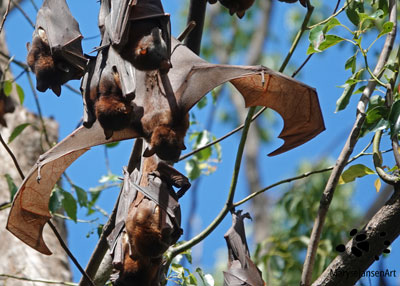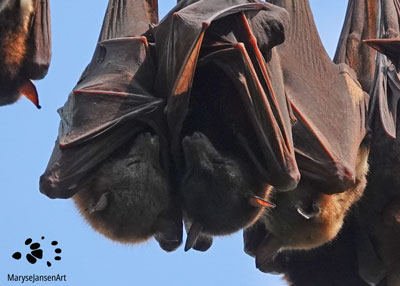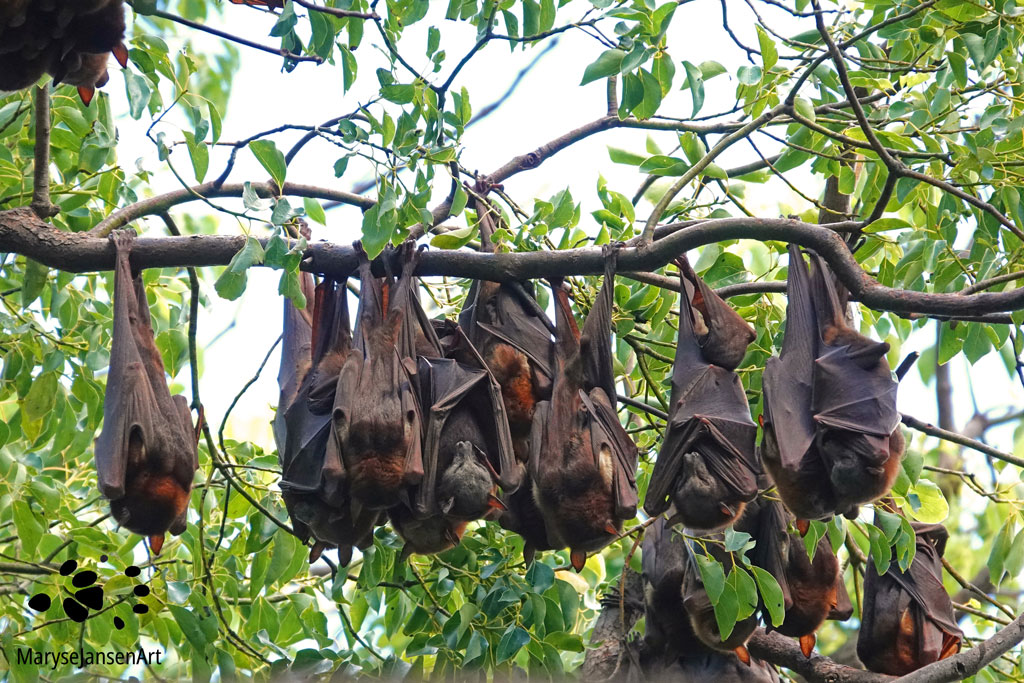Wildlife Photography with marysejansenart
Temporary guests in the local Flying Fox Camp

Busy chatter comes from the trees overhead. The colony of Flying Foxes, which are also known as Fruit Bats, is even noisier then usual. I look up and notice that their numbers have increased. This colony normally consists of Black Flying Foxes and Grey-headed Flying Foxes but now there are a number of red-brown, smaller looking bats in the camp as well. These are Little Red Flying Foxes! They are the smallest amongst the Fruit Bats, but still a relatively large bat with a body length of about 20cm and a wingspan of around 1 metre!

Table of Contents
A Nomadic Species
Little Red Flying Foxes are a nomadic species and like to roost in existing camps with other Fruit Bats which are of the more homely type. They do end up on the bottom of the pecking order though. Quite literally, as they are forced to roost on the lower hanging branches. Most Fruit Bat species keep each other at an arms length when hanging in the trees. These little guys however, tend to hang in small groups very close together. It has been known that such a cozy clump of bats can get too heavy for the branch they’re hanging off…
The reason the Little Red’s are nomadic is that they rely on the blossoming of certain trees. Their favourite food is the nectar and pollen from Eucalyptus (Gum) and Melaleuca (Paperbark) Trees. The flowering season of these trees is quite short and the bats go where the food is.
For me, it means that I can only see them near me during short periods of the year. Because the flowering season is short it is a bit unpredictable when exactly that will be. Usually in (late) summer. The bats follow the blossoms down the east coast and they can do so in very large numbers. If there’s not enough food around they might have a go at the fruits in fruit trees (hence the name Fruit Bats). They can’t bite the fruit like the other Fruit Bats do, they only lick it!
A noisy bunch
I don’t get to see them feed as that is a night time activity for them. During the day they hang out in their camp and squabble with the other Little Reds. The chatter is a constant noise coming from a roosting camp at day time.
At dusk time, the bats get even more restless. More and more start circling the camp until they’re all ready to fly out for the night and feed. It’s a magnificent sight when they all fly out! They can travel quite a distance in search of food.
Bats are not only noisy during the day. At night, you can hear them shriek and squabble over food as well. I have become quite used to Fruit Bats visiting my garden at night, hearing the flapping of their wings and their vocal expressions.
Socializing during the day, going out to feed at night…it makes you wonder when they sleep! They do find the time to take some naps during the day. I find it quite adorable how they fold themselves in their wings as if wrapping a blanket around them! Don’t you?

The Little Red’s have arrived!
While I’m working on this post it occurs to me that it could be the right season for me to see them. I go and visit my local roosting camp and they are there allright! Their red-brown fur, hairless legs, red-brown wings and clump-hanging behaviour makes it easy to recognise them and distinguish them from the other bat species. I think there are at least a thousand, maybe two!!! They are actually hanging out at the outskirts of the existing camp, which I suppose also tells us something about that pecking order between them and the other bats that I mentioned above. It’s like some new suburbs have been added to the camp!
Interestingly, when I go back once more the next day, the camp is completely reorganised! Now the other bats have taken up the top layers of the trees, including those of the ‘new suburbs’. The Little Red’s have spread out through the whole camp as well but are all to be found on the lower branches indeed! It makes me wonder if they had just arrived yesterday and a new order has established today?
A smelly camp
The camp has a particular smell, not the most pleasant one, but it’s not too bad at the moment. The smell is not caused by their droppings, they do keep their camps clean. While hanging in the trees they do not defecate. Being upside down as they are, that would not have a good result! So they do it when they’re in flight, mostly at their feeding-sites. Many Australians (in northern and eastern parts of the country, which is the range of these animals) would be familiar with the nightly feeding visits of Flying Foxes to their gardens and the splattered feces they leave behind after feeding.
So, what does cause the smell then? Flying Foxes spread an odour to help identify each other. When mothers return from a feeding outing they can find their young back based on scent. Males also use the odour to mark their territory. During the mating season the smell gets stronger as the bats also use it to attract a partner. Because there are so many bats close together, the experience can be a bit intense for the human nose!
Important pollinators
Cute, noisy, smelly … whatever you may think of them, the Little Red Flying Foxes have a very important job to do in our ecosystem. Certain tree species produce most of their nectar at night. This means that the birds and the bees that mostly feed during day time can not pollinate these trees. Because the Little Red Flying Foxes travel far and wide and feed at night they are the ones to service these trees and this makes them incredibly important pollinators!
I’d like to invite you to think for a moment about what that means … If the Gum Trees weren’t pollinated and wouldn’t reproduce, that would affect a huge number of species in the ecosystem. For instance, it means there wouldn’t be any food for the koalas … These bats play a serious part in keeping our native forests alive!
For you to experience the noise, the restlessness and the squabbling that goes on in the camp I have created a special edition in my ‘Come for a walk in the Australian Bush’ video series:
If you’d like to purchase ‘Cozy Bunch’ or would like to see what it looks like on the various products, please head to my shop.


